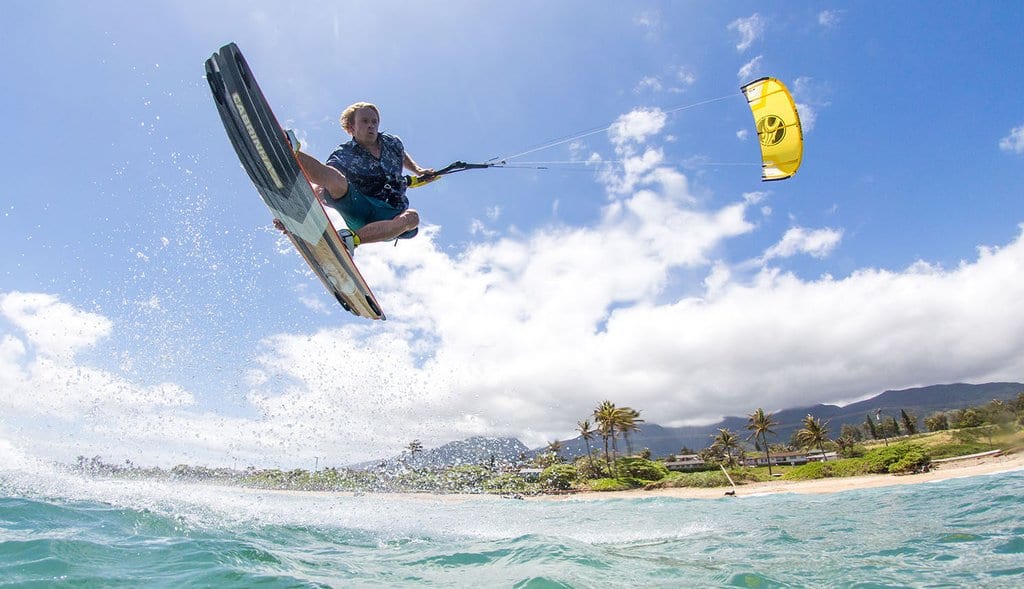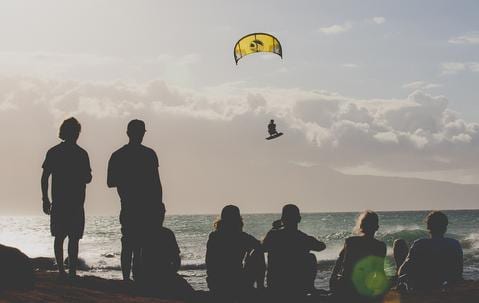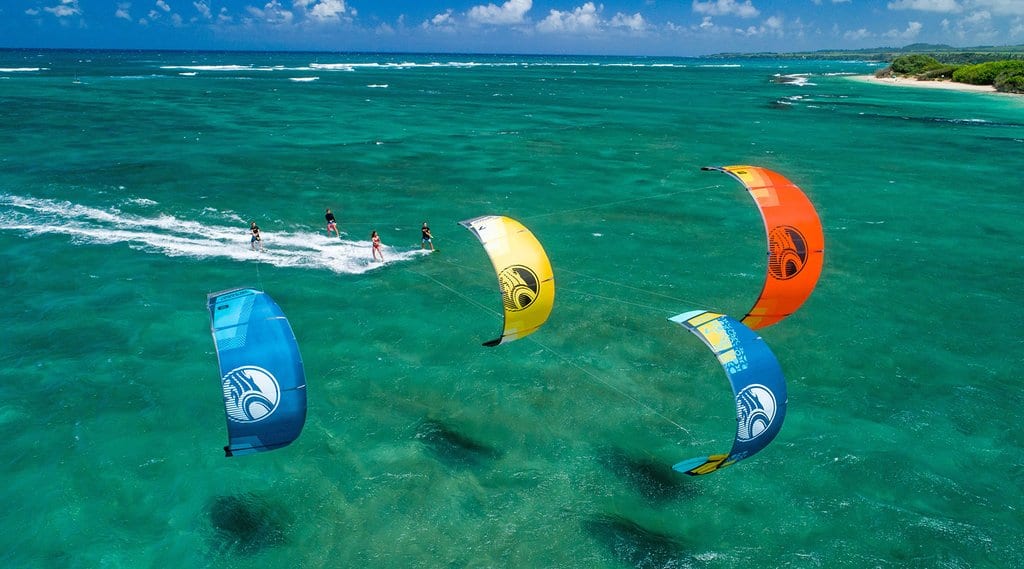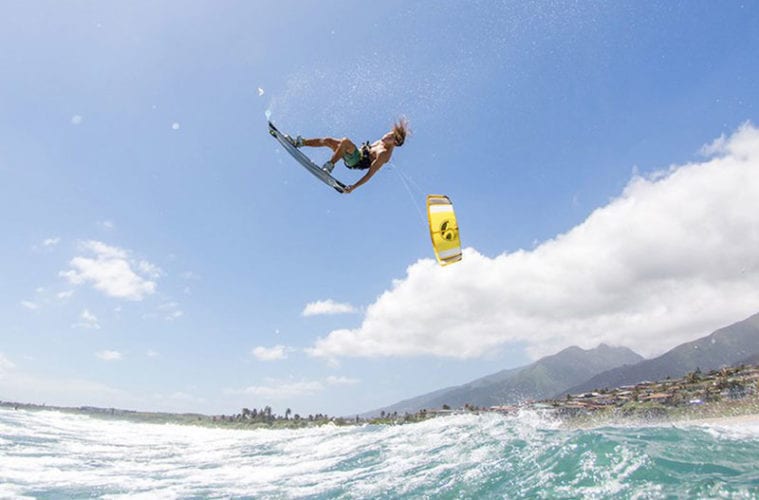Being one of the best kite spots in the world, Maui should be high up on your kitesurfing travel list. What Maui offers is pure kiteboarding gold, wrapped up in a package that is hard to beat. This handy guide from James Boulding is full of tips for travellers to the hallowed island in the Pacific.
Viewed as the spiritual birthplace of kiteboarding, the Hawaiian island of Maui certainly evokes vivid imagery in any water sports enthusiast’s mind. Sadly, thanks to its position as a Mecca for kiteboarding, a large percentage of kiters often write Maui off as a destination as they think they aren’t good enough to ride there. While it is true that many of the world’s biggest kite brands and some of the best riders on the planet get to call Maui home, it’s also home to some of the best kiteboarding the world has to offer, and it’s far easier to reach than you might think…
Mystique vs. Reality
There is a mystique about the island, and my preconceptions about the island were daunting. Before I journeyed there for the first time, even as a sponsored and reasonably competent kiteboarder, the very talk of Maui had me dreaming up scenarios with massive, building-sized waves and conditions I felt anxious to confront. Along with my slight hesitance to ride giant waves, almost every kiteboard film made in the early days was either shot entirely on Maui or had major sections that were filmed there. Back in the day kite legends were made, guys like Pete Cabrinha, Robby Naish, Flash Austin, Elliot Leboe, Lou Wainman, Mauricio Abreu, Jason Stone and Andre Phillip. They graced the pages of magazines and threw down so hard on two line kites for the cameras it was tough to comprehend! Even thinking about turning up there and sharing a hallowed piece of water with my heroes made me weak at the knees.
In reality, I couldn’t have been more wrong, apart from the possibility of building-sized waves that are certainly available if you know where to look. There is such a diverse range of spots and conditions; it doesn’t matter what your level is, there is always a great place to ride which will suit you. It’s no coincidence that Cabrinha and Naish along with a whole host of brands from other sports have their roots firmly planted on the island.
 The trade winds blow like clock work throughout the summer months. I’ve had a few instances, as I am sure you have, when I’ve become eager and excited after loading a WindGuru forecast that was set to the default, Maui, rather than wherever in the world I was actually located. It seems like the forecast for Maui always looks good!
The trade winds blow like clock work throughout the summer months. I’ve had a few instances, as I am sure you have, when I’ve become eager and excited after loading a WindGuru forecast that was set to the default, Maui, rather than wherever in the world I was actually located. It seems like the forecast for Maui always looks good!
Maui has indeed gone through cycles of change throughout the years, but you can throw out any misconceptions about unfriendly, local kiters. The scene is one of the most welcoming I have experienced, and the amount of post-session beers offered probably tops that chart. (Note to self: Work on post-session-beer-offered-by-destination chart.)
Know where to surf
Kiteboarding, arriving late to the watersports party, has had to take what was on offer regarding launch spots. The famous Kite Beach is situated upwind (thankfully not downwind) of a sewage plant, just a stone’s throw from the airport. There are numerous sandy locations to rig up and launch from, with quality waves just a few hundred metres out to sea. Known as Kanaha, this stretch of the North Shore is the epicentre of kiteboarding on Maui. Huge turtles mope through the water, and the view of the island when looking back to shore is simply stunning. The water temperature never gets below 20 degrees (75 Fahrenheit), so the majority of people don’t use a wetsuit. However, keep in mind the wind chill, and if you get cold easily, it’s best to bring a neoprene top or shorty.
Localism is often a point of concern on Hawaii, especially in the surf culture. Tales of the locals abusing tourists in the lineup by telling them to go back to where they came from and aggression aimed at visitors certainly plays on the mind. However, this situation, even in surfing, has been cleaned up a lot. Sure, there are local breaks where you probably don’t want to find yourself if the surf conditions are perfect, but it’s the same anywhere. Generally speaking, if you have the skill to ride these Hawaiian peaks when they are firing, you should already know what to expect and how to act. Nowadays, the current climate is definitely in a better state. Also, the situation changes once the wind is on because the waves are suddenly a lot less precious to the purist surfers. Abiding by a few island rules will prevent any issues and keep the aloha respect high.
With such an abundance of waves and wind, Maui should be high on your travel list. If you feel out of depth in the waves on the North Shore, then alternatives such as Kihei or Waiehu offer up a different scenario. You’ll be surprised at the different wave options that can be found around the island on any given day. Ho’okipa is a famous North Shore option but, because of the quality, it is often busy with surfers. Also, once the wind fills in, the windsurfers will be out in force. Island rules dictate that no kiters are allowed when there are 10 or more surfers and windsurfers in the water. The lifeguards are right on the spot, so you need to be on it and get your math right if you want to score waves there. If you manage to get it good, the point is a superb right-hand wave that allows for numerous hacks before reaching the inside and riding out through the channel. A common option when the water is busy is Lanes, just downwind from Ho’okipa. Lanes shares the same launch as Ho’okipa and is often far less busy. Launching and landing can be a bit tricky because the wind wraps around the coast and becomes gusty. Also, the only access to the water is off a reef shelf. A few riders even opt to use reef shoes to protect their feet while they walk out, then they tie their shoes onto their harness while they session. These factors make Lanes and Ho’okipa, not for the faint of heart. Exploring the coastline closer to Kanaha is the easier option, and there are plenty of breaks all the way down.
The Roots of Cabrinha
Since its creation in 2000, Cabrinha has had its DNA firmly rooted to the island. The wide diversity of conditions makes it the perfect place for the marketing and R&D team to hatch ideas and take a product from concept through the testing phases. With the annual photo shoot on Maui, team riders get to push the new gear to the limits while finding locations to show off specific types of gear. There aren’t too many places where all these variables line up, but Maui always delivers. Sometimes we need to let things play out on a day-by-day basis, allowing the plan to be flexible depending on the forecast. The famous Maui kickers, usually best at Pro Beach, are some of the best ramps a kiteboarder will find for launching into various on and off axis spins. With more and more park events springing up around the globe, and the Kite Park League offering a year-round tour, kicker tricks have been growing in popularity. The more difficult, flip-and-pass tricks inspired by wakeboarding are now being landed by kiteboarder. One side of the sport that has recently blown up on the island is hydrofoiling. No matter how strong or light the wind is, there is a dedicated community flying around on foils, chasing rolling swells and perfecting their skills. The surf industry here is so rich with talent that the introduction of foiling has sparked a boom in excitement about what these magical beasts are capable of when attached to a board of any kind.
Planning a Trip to Maui
Getting to Maui is a lot cheaper than you might think, flights from Europe can be found for between 600 and 800 Euros. From the US, of course, it is a relatively short flight too. The airport to search for is Kahului, interestingly the price for getting board bags in and out has recently changed too with Hawaiian Airlines now stating that a board bag can contain any number of boards as long as it isn’t over 23kilos for $100. They used to charge $100 per board, and the staff were not afraid to open up bags and count the boards and charge a small fortune!
We recommend looking to stay around the Paia, Spreckelsville and Kahului areas to be close to the action on the North Shore. You will definitely need a rental car to get around and get the most out of your trip. It would be criminal not to explore the island and discover some of the delights on offer, from the bamboo forests, waterfalls and the Haleakala National Park and volcano are all a “must do”.
There is a wide variety of food and drink available on the island, from whole food superstores to stunning restaurants overlooking the sea there is something for everyone. It’s not the cheapest place on the planet, but you can live here on a budget if you want to. It’s not really a party island, most of the locals are in bed early so they can get up at the crack of dawn for a surf or yoga session. However post session beers can always be had, either in the car park or in Paia where there the after kiting vibes continue.
Accommodation can be expensive, so it’s good to shop around, with options ranging from hostels and campervans at the budget end all the way to beach front mansions and 5-star hotels there should be something that suits you. The AirBnB, HomeAway and Booking websites all have a plethora of options available.
It’s actually remarkably easy to fall in love with this little volcanic island that rises almighty from the deep depths of the Pacific Ocean. Situated over 5-hours by plane from the nearest landmass, it’s easy to see why there are an abundance of waves. Plus, the tropical landscape and reliable trade wind make you feel like you really have arrived in paradise. If you leave all your preconceptions at the airport and arrive with respect, you will quickly see for yourself what the fuss is all about. In fact, you’ll probably find yourself wanting to come back!
This article first appeared on Cabrinha’s blog here: https://www.cabrinhakites.com/blogs/news/kiteboarding-on-maui-have-you-been-yet


